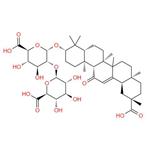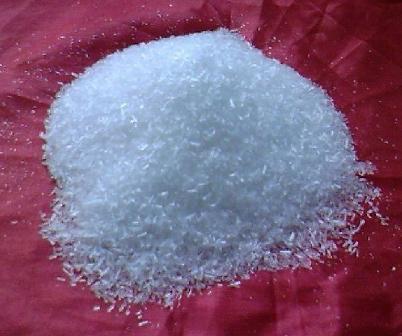Uses of Glycyrrhizic acid
Mar 25,2022
General description
Glycyrrhizic acid (GL) is extracted from the root of the licorice plant; Glycyrrhiza glabra. It is a triterpene glycoside with glycyrrhetinic acid that possesses a wide range of pharmacological and biological activities. When extracted from the plant, it can be obtained in the form of ammonium glycyrrhizin and mono-ammonium glycyrrhizin. Glycyrrhizic acid has been developed in Japan and China as a hepatoprotective drug in cases of chronic hepatitis. From January 2014, glycyrrhizic acid as part of the licorice extract was approved by the FDA as an existing food sweetener. It was approved by Health Canada to be used in over-the-counter products but all the products are currently on the status canceled post marketed. Glycyrrhizin is a saponin-like compound that provides the main sweet flavor for Glycyrrhiza glabra (licorice), with potential immunomodulating, anti-inflammatory, hepato- and neuro-protective, and antineoplastic activities. Glycyrrhizin modulates certain enzymes involved in inflammation and oxidative stress, and downregulates certain pro-inflammatory mediators, thereby protecting against inflammation- and reactive oxygen species (ROS)-induced damage. Glycerrhizin may also suppress the growth of susceptible tumor cells. A widely used anti-inflammatory agent isolated from the licorice root. It is metabolized to GLYCYRRHETINIC ACID, which inhibits 11-BETA-HYDROXYSTEROID DEHYDROGENASES and other enzymes involved in the metabolism of CORTICOSTEROIDS. Therefore, glycyrrhizic acid, which is the main and sweet component of licorice, has been investigated for its ability to cause hypermineralocorticoidism with sodium retention and potassium loss, edema, increased blood pressure, as well as depression of the renin-angiotensin-aldosterone system.
Uses and Pharmacology
1.Glycyrrhizic acid is the main component of the sweetness of licorice.The advantage of using glycyrrhizic acid instead of sucrose to process functional foods such as low sugar or sugar is becoming more and more important. At present, the research on the structural modification of glycyrrhizic sugar chains to improve the sweetness is rare. The glycosylation modification of compounds can be used as an effective means for the development of functional sweeteners.The sweetness of glycyrrhizic acid and its structural analogues were compared by sensory evaluation.The sweetness of methyl glycyrrhetinate-glucoside was higher than that of glycyrrhizic acid, while the sweetness of methyl glycyrrhetinate-galactoside was It is slightly lower than glycyrrhizic acid, but also much sweeter than sucrose.
2.Glycyrrhizic acid (GA, or glycyrrhizin) is a saponin of licorice root. GA is an amphiphilic molecule: the hydrophilic part is represented by the glucuronic acid residues, and the hydrophobic part is the glycyrrhetic acid residue. GA has very long history of use. It has been known since ancient times in ancient China, Egypt, Japan (Shibata, 2000). Licorice is widely used in traditional Chinese and Japanese medicine. For the past 50 years the biological and therapeutic activity of GA has been intensively investigated in Asia and Europe.There are a number of data on the antiviral activity of glycyrrhizin against various viruses. Thus, it was shown that GA at concentrations 0.04-4.8 mM inhibits the replication of the Epstein-Barr virus (human herpesvirus type 4 virus) in vitro (Lin, 2003), the GA selectivity index is 2 times higher than that of the antiviral drug Zidovudine, and 2 times lower than the popular drug Acyclovir. Also in this work it was established that the mechanism of GA action is not associated with direct inactivation of the virus. Presumably, the effect of GA occurs at the stage of virus penetration. It was shown that glycyrrhizic acid could inhibit the replication of coronavirus SARS in vitro . Recent research of the antiviral activity of GA and its various derivatives were carried out on the Vero cell line obtained from the kidney epithelium taken from an African green monkey. It was found that at a concentration of 365 μM GA inhibits the cytopathic effect (destruction of cells) of the virus in 50% of infected cells. At the same time, the GA concentration at which the cell viability decreases by 50% is more than 24 mM[1].
3.Drug delivery systems have become an integral part of anticancer drugs today. Design of novel drug carriers may lead to significant enhancement in antineoplastic therapy. Glycyrrhizic acid (GA), which is the most important active ingredient extracted from the licorice root shows great potential as a carrier material in this field. Recent studies have indicated that the combination of GL andfirst-line drugs had better therapeutic effects on cancers. GL showed a series of anti-cancer-related pharmacological activities, such as broad-spectrum anti-cancer ability, resistance to the tissue toxicity caused by chemotherapy and radiation, drug absorption enhancing effects and anti-multidrug resistance (MDR) mechanisms, as a carrier material in drug delivery systems. It introduced the current research progress on pharmacological mechanisms of GL and development of GL-based drug carriers in anti-cancerfield to provide basis for the application prospects of GL. The design of novel GL-based drug delivery systems will bring new opportunities and challenges to anti-cancer therapy[2].
Figure 1 Anticancer mechanisms of GL[2].
Synthesis
To establish a technique for preparing glycyrrhizin acid (GA) by ultrafiltration-complexation extraction. Methods The effect of pH on the extraction rate of GA from ultrafiltrate was investigated in the range of 4—8; The orthogonal test was used to optimize the technological conditions for complexation extraction of GA; The extraction conditions of GA were determined by investigating the type and concentration of the extractant. Results The optimum extraction conditions for GA were as follows: pH value of Glycyrrhiza uralensis ultrafiltrate was adjusted to 2, TRPO-sulfonated kerosene (5∶95, volume percent), volume ratio of organic phase to aqueous phase was 1∶1, and average extraction rate of GA reached 99.2%. The best back extraction conditions for GA were as follows: 22.5 mmol/L NaOH aqueous solution was used as the stripping agent, the volume ratio of organic phase to stripping agent was 1∶1, the single back extraction rate of GA reached 98.8%, and the total transfer rate of GA was 98.1%. Conclusion Ultrafiltration-complexation extraction technology can be used as a new process for the preparation of GA.
The content of active components in licorice extract is low, there are many macromolecular impurities, and glycyrrhizic acid and TRPO have surface activity. The complex extraction technology is directly applied to the separation of glycyrrhizic acid in licorice extract, and the emulsification phenomenon in the extraction process is serious [17]. Therefore, in this experiment, ultrafiltration is used as the pre technology to effectively remove the suspended solids and soluble macromolecular impurities in the licorice extract while retaining glycyrrhizic acid, greatly reduce the viscosity of the extract, greatly reduce the emulsification phenomenon, improve the extraction mass transfer effect, make the application of complex extraction technology in the separation of glycyrrhizic acid applicable, and open up a new process route for the preparation of glycyrrhizic acid. In the previous complex extraction of glycyrrhizin, the extraction rate of glycyrrhizic acid was very low. After analysis, glycyrrhizic acid contains carboxyl groups and has strong acidity. Under the condition of high pH value, glycyrrhizic acid in the ultrafiltration exists in the form of ions, which is not conducive to complex extraction. Therefore, this experiment focused on the effect of pH value of ultrafiltration on the extraction rate of glycyrrhizic acid. The extraction rate of glycyrrhizic acid was greatly improved by reducing the pH value of the ultrafiltration. Moreover, in view of the selective enrichment effect of complex extraction technology on the dilute solution of polar organic matter, this experiment uses the non concentrated licorice ultrafiltration (0.05 g / ml) for direct complex extraction. Compared with the traditional process of concentrating the extract during physical extraction, this treatment method not only saves the production cost, but also makes the process more concise, which is conducive to the industrial production of glycyrrhizic acid. Because the purpose of this experiment is to extract more glycyrrhizic acid by complexation. Under the optimized process conditions in this experiment, the efficient transfer of glycyrrhizic acid from ultrafiltration to complex extractant and then to alkaline back extractant was realized. The glycyrrhizic acid contained in glycyrrhizic acid ultrafiltration was almost completely complexed extraction and back extraction, and the total transfer rate of glycyrrhizic acid was as high as 98.1%[3].
References
1.Selyutina O. Y. & Polyakov N. E., "Glycyrrhizic acid as a multifunctional drug carrier - From physicochemical properties to biomedical applications: A modern insight on the ancient drug," Int J Pharm, Vol.559(2019), pp.271-279.
2.Su X., Wu L. & Hu M. et al., "Glycyrrhizic acid: A promising carrier material for anticancer therapy," Biomedicine & Pharmacotherapy, Vol.95(2017), pp.670-678.
3.Wang Heying: extraction and purification of glycyrrhizic acid and preparation of its structural analogues: Tianjin University of science and technology, 2019.
- Related articles
- Related Qustion
- Glycyrrhizic acid: Biological activity and Uses Jul 17, 2024
Glycyrrhizic acid is mainly used as a flavouring and sweetening agent for bitter drugs, beverages, candies, and chewing gum.
Sulfanilic acid, also known as p-aminobenzenesulfonamide, with the molecular formula C6H8N2O2S, is an organic compound with medicinal value.....
Mar 25,2022APICefepime is an oxymino b-lactam with an amino thiazolyn side chain classified as a fourth-generation cephalosporin. In general, it has a wider spectrum and greater potency than the third-generation cephalosporins.....
Mar 25,2022APIGlycyrrhizic acid
1405-86-3You may like
Glycyrrhizic acid manufacturers
- Glycyrrhizic acid
-

- $1.00 / 1g
- 2025-12-12
- CAS:1405-86-3
- Min. Order: 1g
- Purity: 0.99
- Supply Ability: 20 tons
- Glycyrrhizic acid
-

- $0.00 / 1kg
- 2025-12-12
- CAS:1405-86-3
- Min. Order: 0.001kg
- Purity: 99.99%
- Supply Ability: 2000000T
- Glycyrrhizic acid
-

- $0.00 / 1KG
- 2025-12-12
- CAS:1405-86-3
- Min. Order: 1KG
- Purity: ≥98% HPLC
- Supply Ability: 1000KG






